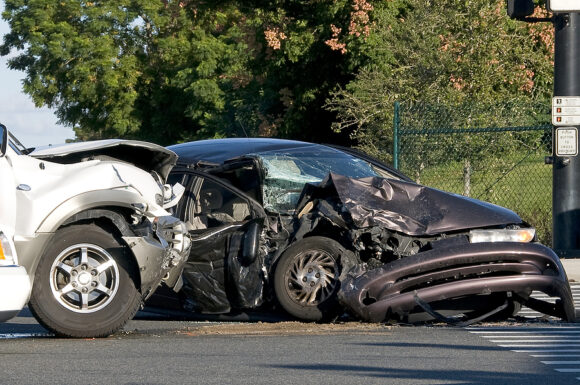Today’s crash forensics field is a high-tech industry with near-perfect accuracy capabilities. So why aren’t adjusters and insurers tapping into it more often?
In most accidents Michael Merolli investigates, he’s able to tell you whether it was a 90-pound gymnast or a 220-pound basketball player driving the car. That’s because Merolli, SIU accident reconstructionist for MAPFRE USA in Boston, is a crash research and reconstruction expert who understands where to look and what technology is in place to help dissect accidents.
Crash forensics, accident reconstruction, and the research behind the what and how of an accident uses science, technology, and intuitive thinking to get to the bottom of the causes. Using detailed measuring techniques and tools, in-auto computer modules, and state-of-the-art equipment, reconstructionists can show with near-perfect accuracy what happened seconds before, during and after most accidents. They can tell who was driving, who was sitting where, and what speed the car was traveling at, and what factors contributed to the accident.
It’s a field that has become increasingly more important. According to the latest statistics available via the National Highway Traffic Safety Administration (NHTSA), there were more than 5.4 million motor vehicle accidents that occurred in 2010. Of those accidents, nearly 33,000 fatalities occurred as well as more than 2.2 million injuries sustained.
Yet crash forensics methods do not play a front-and-center role in today’s claim settlement process.
History
It’s not because the practice isn’t already vetted. Traffic accident reconstruction has been part of the insurance landscape since 1985, when formalized national guidelines and training standards were put into place by the NHTSA. Since, accident reconstruction and forensics processes have become technology-driven and achieved a surprising level of accuracy.
In 1994, General Motors became the first company to install airbag modules that deploy airbags in its automobiles. By 1998, Ford had followed suit. The data stored in these modules served as some of the forensic industry’s most essential data.
Then came the CDR technology used today. Ten years ago, a company called Vetronix created the first crash data retrieval (CDR) tool. Flash forward to 2006 when Vetronix Aftermarket merged with Bosch Automotive Aftermarket. Since that time, Bosch has been the sole manufacturer of the CDR tool.
It took five more years for the CDR technology to gain wide acceptance, which came first through use in law enforcement cases. In fact, CDR and accident forensics in general have come slowly into the insurance settlement industry. Effective Sept. 1, 2012, NHTSA has implemented a rule that has a presidential order pending. That rule would require CDR technology in all U.S. vehicles.
Outside of Mainstream
Yet crash forensics has yet to break into a more mainstream role in the claim settlement process. Why? Partly because it’s just not economical, says W. R. “Rusty” Haight. Haight, director of The Collision Safety Institute in San Diego, believes that the dollar value, while there, may not always be justified, depending on the claim. Also, Haight thinks it’s a tougher sell from a customer service standpoint.
“It’s a battle of competing interests,” he says. “If I have 30 days to settle a claim and it’s going to take 60 days to get a result back from a lab, I’m not going to have enough time to do it.”
Flawed thinking, in Haight’s estimation. “In any kind of analysis, am I dealing with a claim with only partial information?” He says that a number of claim settlement decisions are based on witness accounts at the scene of an accident. Witnesses, he says, are notoriously wrong and should not be the basis upon which a claim should be settled. Instead, he suggests adjusters begin utilizing airbag module information, data he says is still open to analysis, but it has a lot of good information to be gleaned.
Forensics in Action
To date, accident reconstruction and forensics processes have evolved into a combination of data extraction, measurement, and analysis practices that can pinpoint nearly everything, from the cause of an accident to the DNA of the driver.
That includes determining who was behind the wheel when the accident occurred. As Merolli suggests, he can extract the DNA from imprints on an airbag, as well as the approximate weight of each person in each seat, to determine who was sitting where when the airbag deployed. The airbag modules themselves, he says, store a wealth of information that can more accurately reveal the details of a crash, including the rate of speed five seconds prior to and after the accident.
Stan Oglesby says he employs data from those airbag modules to get insight into speed prior to the crash, engine speed, throttle position (open or closed?), brake position, if seat belts were being used and if the passenger airbag was enabled. That’s enough, he says, to glean enough data to reconstruct an accurate assessment of what happened.
Oglesby, managing partner of Midwest Accident Reconstruction Services, Concordia, Mo., says time is critical. The ideal situation, he says, is to be on the scene shortly after a crash – within a day or two of the accident. That aids in evidence collection and helps preserve more of the evidence before it is lost. Even with metal scratches and damages, time is critical. “Bare metal rusts quickly: within a day or two,” he says.
Oglesby was busy on a freight crossing accident when we first got in touch. His company handles 120 to 130 reconstructions per year, and as a reconstructionist with 23 years’ experience, he knows the importance of using all available data. That day, he was studying sight distances, vegetation, and other factors that could be lost in just a day’s time.
“The goal is to get to the scene before things change,” he says, especially during seasonal changes, where the view today wasn’t the same view as yesterday.
While Oglesby uses the CDR and airbag module information, there are some limitations to the technology. That’s when an investigator’s experience and ability to reason comes into play, he says. His example is driving down a highway, losing control, hitting a median and sliding sideways. “I may still be doing 80 miles an hour, but the tires aren’t spinning anymore because we’re sliding sideways, so the module could be recording zero or something like you’re going from 60 to 20 miles per hour in a second. That’s not possible through braking.”
An intersection crash investigation Oglesby remembers proved the accuracy of human science in the investigative process. Because some states require that forensics investigators get permission from vehicle owners to download module information, he and his team, lacking that permission, took measurements and calculated speeds based on momentum. A few months later, permission to download the electronic data was granted. The result – the speed his team had calculated based on physical evidence was within one mph of what the module had recorded.
Oglesby says forensics can tell what happened, but not why. For example, if the accident involved a pedestrian dressed in dark clothing walking along a highway at night, Oglesby says he can’t determine conclusively if it was a lack of forethought or an attempt at suicide.
Value Increasing
“Can you download the black box?” It’s a call Merolli gets often these days. It’s not coming from law enforcement as much, but from consumers involved in accidents wanting to prove the fault is not theirs.
While the information collected is vital to the accurate settlement of claims, human analysis is just as vital. Merolli says the facts don’t always tell the complete story. He uses the example of a public official who was involved in a high-speed accident. The data recorder showed he could have been traveling more than 100 mph. But Merolli knew better. “We’re fairly certain that speed was over-reported by 20 to 30 miles an hour due to wheel slip.”
Why did the data suggest otherwise? Because data, he says, can’t be intuitive like investigators can. “Based on the fact that the car rolled over and the wheels were in the air, we can time the speed and we do know the vehicle high speed was occurring while the wheels were slipping.”
“It’s not as simple as reading a report,” Merolli says. “You have to read it and understand it in the context of the claim.” The process, he says, is highly accurate. He says when two vehicles both contain crash data the results can be spot on. “I’d say the accuracy is arriving on 100 percent,” he says.
Haight thinks when that data needs to be used is a call made not just by insurer processes, but by adjuster intuition. When to call? “When my claim has characteristics that would justify it,” says Haight. “If I have a claim for a hit-while-parked claim, I’m probably not going to call, unless this guy has had a couple of these claims.”
Another flag, he says, would be a lot of property damage or bodily injury exposure or a combination. Yet Haight wonders if adjusters are limited due to internal communication processes. “If you’re working on the property side and I’m on the bodily injury side, we’re not going to talk. Get the BI (bodily injury) and PD (property damage) guys communicating more clearly on what we’re looking at as an overall claim.”
Adjusters must be intuitive, he says. While there may not always be a need for forensics data and processes, there’s a time and place for it in the adjuster’s arsenal.
Haight says, “If I’m working for ABC Insurance and we’re about to hit policy limits or there’s a question about some specific issue within the claim itself, it might be worthwhile to look at all the information before I make any kind of recommendation or decision.”
This article originally appeared in the winter 2013 issue of Claims Journal. Read the issue.
Was this article valuable?
Here are more articles you may enjoy.


 Trump’s Trade War Forces Canada into Decision on Whether to Hit US Autos
Trump’s Trade War Forces Canada into Decision on Whether to Hit US Autos  VW, Stellantis, Renault Among Firms Fined $495M Million by EU
VW, Stellantis, Renault Among Firms Fined $495M Million by EU  California’s Snowpack Data Likely Signals Another Fire-Prone Summer
California’s Snowpack Data Likely Signals Another Fire-Prone Summer  An Unusually Active Hurricane Season Is in Store for the Atlantic
An Unusually Active Hurricane Season Is in Store for the Atlantic 